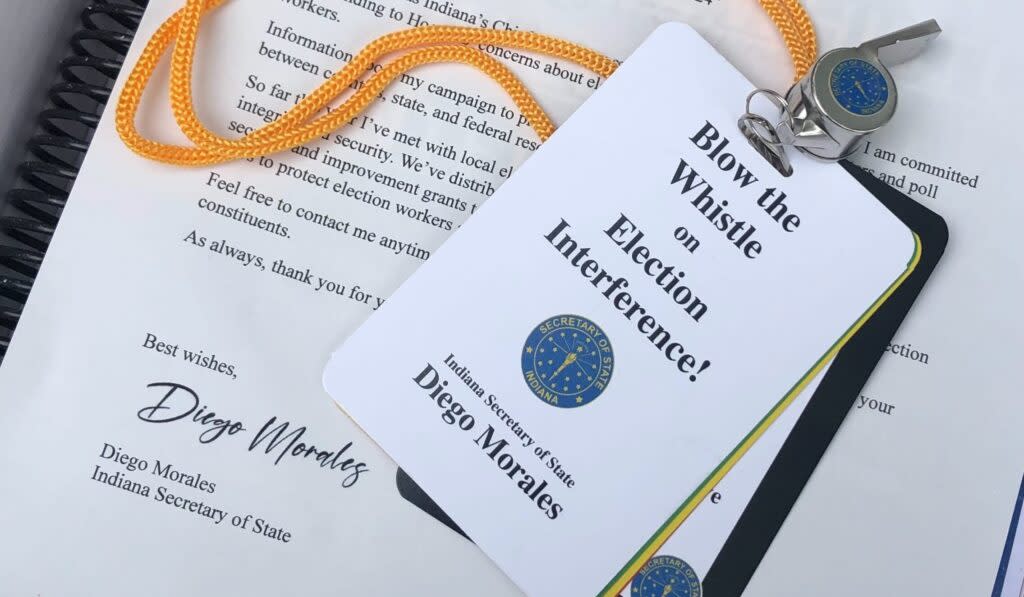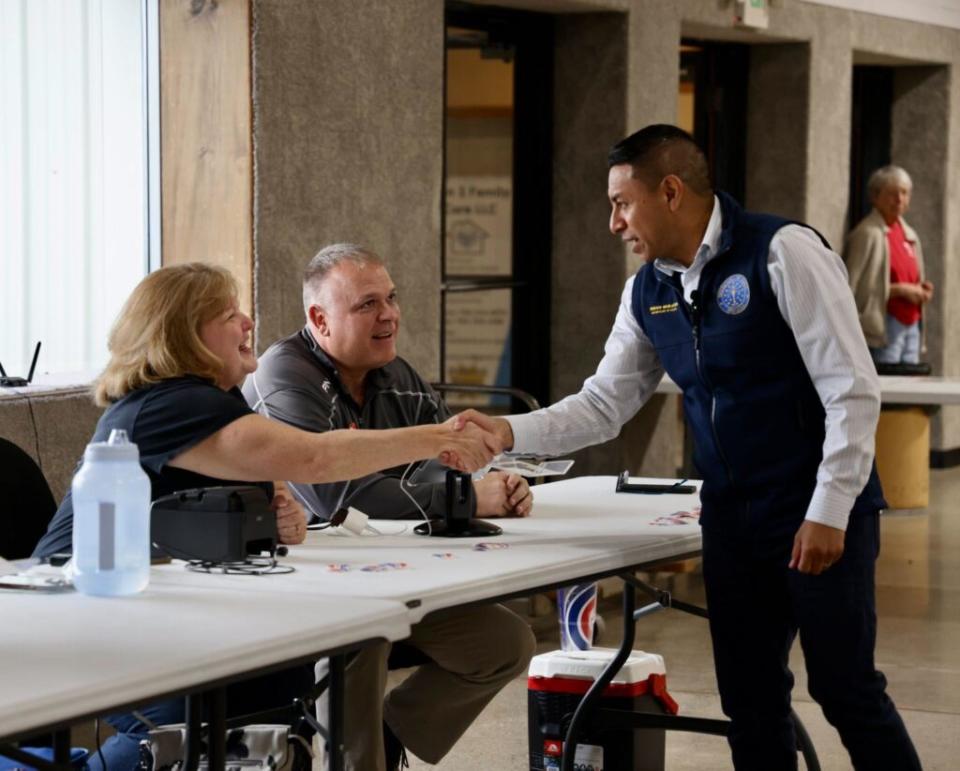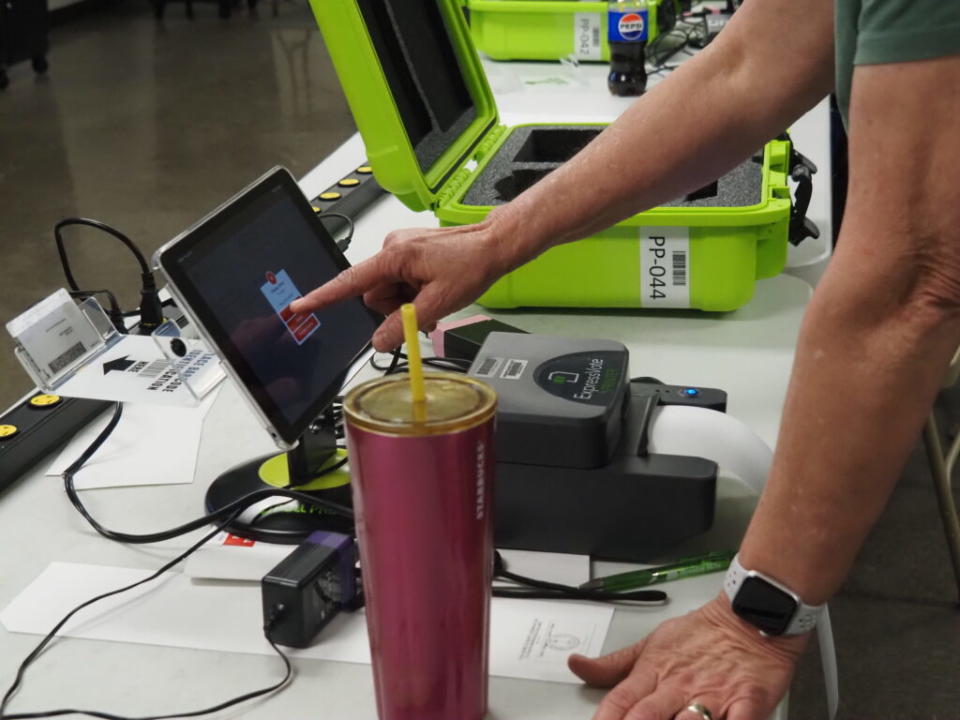‘Blow the whistle’: Indiana’s top election official spends $35k on security guide mailings

- Oops!Something went wrong.Please try again later.
Indiana Secretary of State Diego Morales' 2024 election security guide features a whistle. (Submitted photo)
You’ve got mail!
Hundreds of election administrators, lawmakers, law enforcement officers and others across Indiana — and beyond— slit open heavy white cardboard boxes this spring to uncover glossy election security guides from the state’s top election official, Secretary of State (SOS) Diego Morales.
“Blow the whistle on election interference,” the thick, spiral-bound books read. They’re accompanied by whistles strung on lanyards.
The 180-page document, per SOS spokeswoman Lindsey Eaton, is “a new addition to the library of election guides produced and distributed by the state for election administrators.”
Assembling and shipping 600 guides cost a whopping $35,070. That’s $58.45 each.

Each booklet cost about $45 to print, and each lanyard with whistle and card was about $1.45, according to Eaton. Packing and shipping cost approximately $12 per guide. SOS paid for the initiative with a 2023 State Homeland Security Grant.
“Secretary Morales firmly believes there’s no price tag when it comes to the safety of our election workers,” Eaton said in written responses to a Capital Chronicle inquiry. She highlighted Morales’ three months of visits to all of the state’s 92 counties and said he’d heard “safety concerns” from the election officials he met on the way.
Poll threats and harassment
Ahead of the 2022 midterm election, rural and urban election officials alike told the Capital Chronicle they’d heard negative comments but not threats and harassment.
But abuse appears to be on the rise.
In a national survey of more than 900 election officials released this month, 38% of the officials reported having experienced abuse, harassment or threats because of their election work. That was up from 30% in 2023, according to the left-leaning Brennan Center for Justice, which conducts the surveys.
Of the 16% who specifically said they’d been threatened — defined as expressions communicating an intention to harm or injure that imply imminent risk to a person’s well-being and safety — more than half said the threats were made in person. They also came in over the phone, email, social media, snail mail and more, according to the survey.
Seven in 10 respondents said they felt threats against election officials have increased since 2020, the same share as in 2023.

Indiana office-holders are paying attention.
State lawmakers approved legislation in March making it a Level 6 felony to threaten an election worker as well as to obstruct, interfere with, or injure an election worker. As for SOS?
“Leading up to the November General Election, (Morales) continues to place a major emphasis on keeping poll workers and election administrators safe,” Eaton wrote. “The election security guides and materials were designed to encourage threat awareness and informed election security and safety collaboration and response between election administrators and allied resources including state and federal emergency response agencies, local law enforcement, and local emergency response agencies.”
That’s why local law enforcement agencies, county emergency management offices, state and federal emergency management offices, were among the recipients.
In addition to county clerks and election administration offices, the office also sent guides to state lawmakers, Indiana’s congressional delegation, the U.S. Election Assistance Commission, members of the National Association of Secretary of States Election Committee and the Voting System Technical Oversight Program (VSTOP) at Ball State University. VSTOP tests all the election equipment used in Indiana.
What’s inside
The guide is a “compilation of materials from authoritative sources,” including the U.S. Department of Homeland Security’s Cybersecurity and Infrastructure Security Agency, four state agencies, a county election board and the Committee for Safe and Secure Elections. Law enforcement and election officials created the latter in 2022 to address violence against election workers and voters.
Just below its list of sources and acknowledgements, however, the guide warns readers the information inside may not be correct.
“This publication is a collection of materials from cited sources. It is presented for education and illustrative purposes and is not intended to be relied on as a legal resource, definitive guidance or administrative directive,” it says. “The State of Indiana does not warrant, and assumes no liability that the information contained herein is complete, up to date, correct, or applicable in any particular situation or circumstance.”
Need to get in touch?
Have a news tip?
“Election administrators, election workers, and persons responsible for safe, secure, and reliable elections are advised to consult with their own legal, security, and public safety advisers about specific situations and actions,” it continues.
The document, which has 18 sections, takes on polling place security plans, election infrastructure security, election worker attacks, suspicious election mail, doxing, swatting, artificial intelligence, photo identification and more.
“The focus of the program is on election worker and voter safety, election security, and state election administration as a component of ‘National Critical Infrastructure,'” Eaton said. “The guide and materials are part of the Secretary of State’s multi-dimensional 2024 program for election safety and security which also includes production of audio-visual training materials, regional training and collaboration seminars, and production and hosting of web accessible election security information.”
It’s not public, however. Eaton said it “has not yet” been published online. High printing costs mean there aren’t physical copies available for everyday residents “at this time,” she added.
SOS photocopied the first four pages of the guide, embedded below, in response to the Capital Chronicle’s inquiry.
2024 Blow the Whistle on Election Interference introduction 5-8-24 GET THE MORNING HEADLINES DELIVERED TO YOUR INBOX
The post ‘Blow the whistle’: Indiana’s top election official spends $35k on security guide mailings appeared first on Indiana Capital Chronicle.

